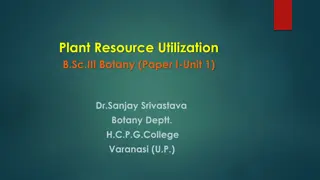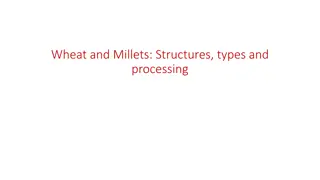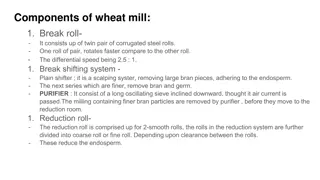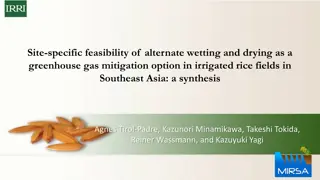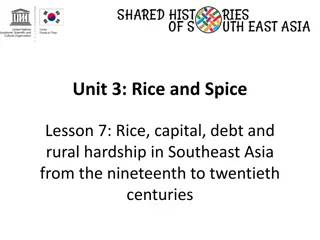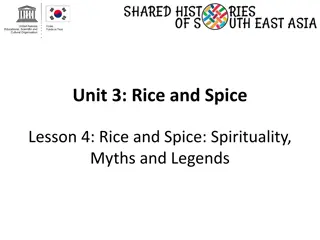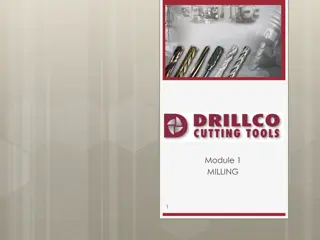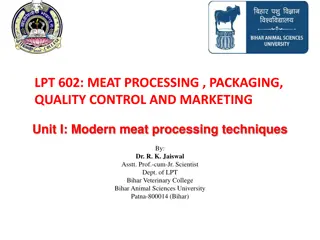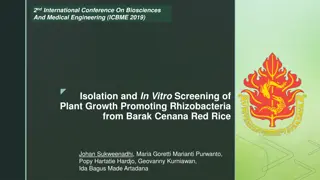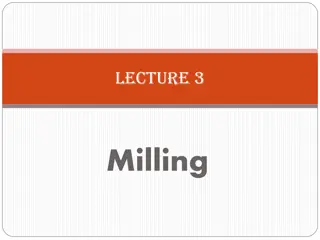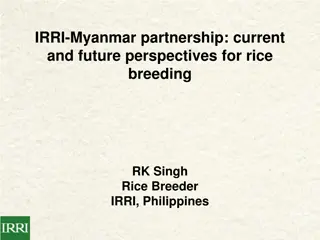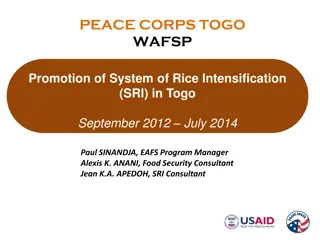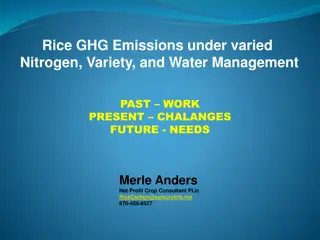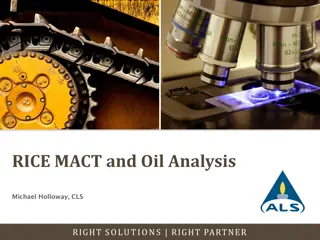Overview of Rice Milling Systems and Modern Processes
Rice milling systems range from traditional hand-pounding equipment to modern, large-scale installations. Various types of mills are used for dehusking and polishing rice, with methods like battery of hullers and sheller-cum-huller mills. The modern rice milling process begins with cleaning to remove impurities, ensuring the production of clean rice while protecting machinery. Cleaning involves the use of machinery like cleaners, which remove foreign matter and increase milling capacity.
Download Presentation

Please find below an Image/Link to download the presentation.
The content on the website is provided AS IS for your information and personal use only. It may not be sold, licensed, or shared on other websites without obtaining consent from the author. Download presentation by click this link. If you encounter any issues during the download, it is possible that the publisher has removed the file from their server.
E N D
Presentation Transcript
MILLING OF RICE Rice milling systems range from the home-scale to the large, complex modern rice- procesing installations. They include hand pounding equipments, single hullers, battery of hullers, emery sheller-cum-huller mills, emery sheller-cum-cone polisher mills and themodern rubber-roller rice mills. Traditional rice milling machinery Traditional rice mills include hand pounding equipments, single huller and battery of hullers, sheller- cum-huller and sheller mills. Hand Pounding A variety of implements are used for the purpose of hand pounding, the more common being: (a) mortar and pestle, (b) Dhenki and (c) hand stone (chakki). Huller mill The huller mill combines both dehusking and polishing process in one operation. Therefore the by- products, husk and bran are mixed together. The average milled rice recovery in the case of raw rice is low 65% or less breakage is high. Besides, it has a larger power requirement per ton of paddy milled than other type of rice mills.
Battery of hullers These mills consist of a battery of hullers. In addition, sieves for cleaning the paddy, reciprocating sieves for removing brokens, aspirator to remove the husk and bran etc are added. The hullers generally work in parallel simply to increase the capacity. As yield from huller is poor with raw paddy, these commercial mills are mostly found in areas where parboiled rice is eaten. Sheller-cum- huller mill Here a disc sheller (emery sheller, emery dehusker) is used for dehusking and the huller is used for polishing the dehusked (brown) rice. After cleaning paddy in a sieve, the cleaned paddy is dehusked in a disc sheller and the husk is aspirated. The stock from the sheller is fed to hullers for polishing, often with a screen-type paddy separator in between. The mixture is then sifted and aspirated to remove bran and small brokens from head rice. The outturn of rice form this mill is higher by 1-2% over the huller mill for raw paddy.
Modern Rice Milling Process: Cleaning Cleaning is the first step in modern rice milling. It not only enables the production of clean rice but also protects the other milling machinery and increases milling capacity. Cleaning removes foreign matter, such as sand, stones, straw, seeds and pieces of ironfrom paddy. Impurities that are lighter than paddy are removed by an aspirator.Metallic (iron) impurities are removed by the use of a magnet. Impurities larger or smaller in size but heavier than paddy are removed by sieves. or rotating sieves or a combination of both are used. Impurities that have the same size as paddy but are heavier than paddy are removed by specific gravity separators, namely destoners.
Cleaner: The paddy is fed into this machine through an opening in the top. The suction fan draws air through the film of grain and separates all dust and light impurities, which drop to the cone-shaped bottom of the aspiration housing for automatic discharge. The paddy falls to a vibrating sieve with large perforations which removes large impurities such as straws, big stones, etc. The paddy and remaining small impurities fall to the bottom vibrating sieve with small perforations which removes small impurities. The overflow from this sieve is again subjected to strong aspiration to remove the last traces of light impurities.
Destoner The destoner consists of a perforated deck mounted at angle and operated by areciprocating motion. A large amount of air is blown from below through the sieve. When a mixture of paddy and stone is fed at the top of the sieve, the air coming through the sieve stratifies the materials according to their density (or heaviness). The heavier stones remain on the deck and are carried backward to the top end by the reciprocating motion of the deck and discharged. The lighter paddy remains floating and slides down and is discharged from the lower end.
Magnetic separator Type A is a permanent magnet located in such a way that when unclean paddy moves across it, the iron particles are collected by it. The particles are later cleared by hand. Type B is cleaned automatically. The rotating cylinder is turned by the free-flowing paddy. Under the cylinder, there is a half-round magnet. As the paddy passes over the cylinder, iron particles are held by the cylinder s magnetic attraction. As the cylinder continues to rotate, when the cylinder is not moving over the magnet, the iron is automatically released and discharged separately.
Dehusking (Shelling) The object of dehusking is to remove the husk from the paddy with a minimum ofdamage to the bran layer and without breaking the brown rice grain. Disc sheller: It consists of two horizontal iron discs coated with emery. The top disc is fixed to the frame housing, and the bottom disc rotates. The rotating disc can be moved vertically up or down to adjust the clearance between the two discs. The clearance is thus adjusted to the size of the paddy grain. Paddy is fed into the center of the machine. As it reaches the rotating disc, it moves outward by centrifugal force. During its travel outward, whenever it is up-ended, itis caught between the top (stationary) and bottom (rotating) discs and is dehusked by shear. The clearance between the two discs is critical to avoid excessive breakage.






